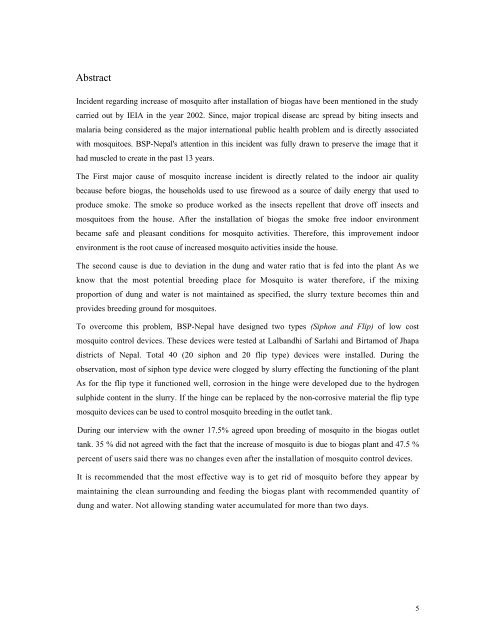Final Report on Mosquito Breeding Research - SNV
Final Report on Mosquito Breeding Research - SNV
Final Report on Mosquito Breeding Research - SNV
Create successful ePaper yourself
Turn your PDF publications into a flip-book with our unique Google optimized e-Paper software.
Abstract<br />
Incident regarding increase of mosquito after installati<strong>on</strong> of biogas have been menti<strong>on</strong>ed in the study<br />
carried out by IEIA in the year 2002. Since, major tropical disease arc spread by biting insects and<br />
malaria being c<strong>on</strong>sidered as the major internati<strong>on</strong>al public health problem and is directly associated<br />
with mosquitoes. BSP-Nepal's attenti<strong>on</strong> in this incident was fully drawn to preserve the image that it<br />
had muscled to create in the past 13 years.<br />
The First major cause of mosquito increase incident is directly related to the indoor air quality<br />
because before biogas, the households used to use firewood as a source of daily energy that used to<br />
produce smoke. The smoke so produce worked as the insects repellent that drove off insects and<br />
mosquitoes from the house. After the installati<strong>on</strong> of biogas the smoke free indoor envir<strong>on</strong>ment<br />
became safe and pleasant c<strong>on</strong>diti<strong>on</strong>s for mosquito activities. Therefore, this improvement indoor<br />
envir<strong>on</strong>ment is the root cause of increased mosquito activities inside the house.<br />
The sec<strong>on</strong>d cause is due to deviati<strong>on</strong> in the dung and water ratio that is fed into the plant As we<br />
know that the most potential breeding place for <strong>Mosquito</strong> is water therefore, if the mixing<br />
proporti<strong>on</strong> of dung and water is not maintained as specified, the slurry texture becomes thin and<br />
provides breeding ground for mosquitoes.<br />
To overcome this problem, BSP-Nepal have designed two types (Siph<strong>on</strong> and Flip) of low cost<br />
mosquito c<strong>on</strong>trol devices. These devices were tested at Lalbandhi of Sarlahi and Birtamod of Jhapa<br />
districts of Nepal. Total 40 (20 siph<strong>on</strong> and 20 flip type) devices were installed. During the<br />
observati<strong>on</strong>, most of siph<strong>on</strong> type device were clogged by slurry effecting the functi<strong>on</strong>ing of the plant<br />
As for the flip type it functi<strong>on</strong>ed well, corrosi<strong>on</strong> in the hinge were developed due to the hydrogen<br />
sulphide c<strong>on</strong>tent in the slurry. If the hinge can be replaced by the n<strong>on</strong>-corrosive material the flip type<br />
mosquito devices can be used to c<strong>on</strong>trol mosquito breeding in the outlet tank.<br />
During our interview with the owner 17.5% agreed up<strong>on</strong> breeding of mosquito in the biogas outlet<br />
tank. 35 % did not agreed with the fact that the increase of mosquito is due to biogas plant and 47.5 %<br />
percent of users said there was no changes even after the installati<strong>on</strong> of mosquito c<strong>on</strong>trol devices.<br />
It is recommended that the most effective way is to get rid of mosquito before they appear by<br />
maintaining the clean surrounding and feeding the biogas plant with recommended quantity of<br />
dung and water. Not allowing standing water accumulated for more than two days.<br />
5
















